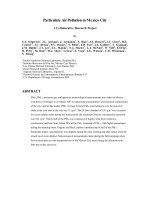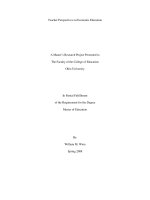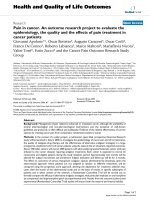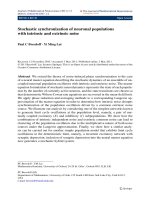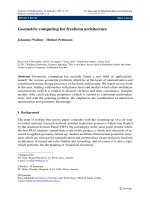ASM 1 Computing research project 1639 FPT Greenwich (Merit Super Sale)
Bạn đang xem bản rút gọn của tài liệu. Xem và tải ngay bản đầy đủ của tài liệu tại đây (2.01 MB, 56 trang )
ASSIGNMENT 1 FRONT SHEET
Qualification
BTEC Level 5 HND Diploma in Computing
Unit number and title
Unit 13:Computing Research Project
Submission date
30/10/2022
Date Received 1st submission
Re-submission Date
Date Received 2nd submission
Student Name
Nguyen Huy Hoang
Student ID
GCH200739
Class
GCH0908
Assessor name
Do Tien Thanh
Student declaration
I certify that the assignment submission is entirely my own work and I fully understand the consequences of plagiarism. I
understand that making a false declaration is a form of malpractice.
Student’s signature
Grading grid
P1
P2
P3
P4
P5
M1
M2
M3
D1
D2
Page 1 of 56
Summative Feedback:
Grade:
Resubmission Feedback:
Assessor Signature:
Date:
Internal Verifier’s Comments:
Signature & Date:
Page 2 of 56
Table of Contents
I.
INTRODUCTION ................................................................................................................... 4
1. Introduction Purpose Of Research ..................................................................................... 4
2. Project Research Scope And Objectives ............................................................................ 4
II. LITERATURE REVIEW ......................................................................................................... 6
1. Review “What is the environmental effect of the e-waste on the countryside in the northern
region if they are handled improperly and lack of concern from residents and even
authorities?” In General ........................................................................................................... 6
2. Review the impact of E-waste on human beings in the past and current now (how it
changed the way we live, what is the trend, pros and cons…).................................................. 6
3. Identify My Topic In The Wider Context.............................................................................10
4. Review research methodologies .......................................................................................15
5. Identify Some Propose Hypotheses. .................................................................................18
III.
RESEARCH IMPLEMENTATION ......................................................................................19
1. Interview ............................................................................................................................19
2. Survey ...............................................................................................................................22
3. Observation: ......................................................................................................................36
IV.
FINDING OF RESEARCH .................................................................................................37
V. LIMITATIONS AND IMPROVEMENTS IN THE FUTURE FOR MY RESEARCH .................43
1. Limitations: ........................................................................................................................43
2. Improvements: ...................................................................................................................44
VI.
CONCLUSION ..................................................................................................................45
Appendix I – Research proposal ..............................................................................................45
Appendix II – Ethical form ........................................................................................................51
References ..................................................................................................................................55
Page 3 of 56
I.
INTRODUCTION
1. Introduction Purpose Of Research
Since the early 2000s, informal e-waste recycling processing has been a severe problem in Viet
Nam as the demand of using electronic and electrical products is increased. E-waste management
in Vietnam also has been facing significant obstacles including a substantial presence of "craft
villages," and a lack of monitoring data. There are other problems that contribute to the restricted
access to these craft communities, including the amount of pollution, waste production, worker
and resident health, and created garbage. This research will cover and discuss the environmental
effect of e-waste on the countryside in the northern region when they are handled improperly and
lack concern from residents and even authorities. Based on this information, my hypothesis about
this problem will be provided and proven clearly by research methodologies.
2. Project Research Scope And Objectives
2.1.
Project Research Scope
My research scope is the status quo of e-waste and people’s behaviour toward it in
mainly Vietnamese northern agricultural provinces such as Thai Binh, Nam Dinh, Bac
Ninh and Ninh Binh, etc…. Specifically, I do research on the region in which the informal
recycling facility has been operating widely. I surveyed approximately more than 200
distinct respondents. To ensure the randomness in gathering the sample data, I have
spread surveys throughout the northern brotherhood groups on some popular social
networks in Viet Nam such as Facebook, Telegram, Twitter, etc…, interviewed any 1
person and observed via watching those kind of this topic in youtube. The collected data
will be analyzed objectively, then draw conclusions about the impact of informal
recycling and the attitude of people toward it.
2.2.
Objectives
I conduct a research on what is the environmental effect of e-waste on the countryside
in the northern region if they are handled improperly and lack concern from residents
and even authorities
Page 4 of 56
Some points of the report:
Definition of e-waste
What happens if the e-waste from electronic manufactory is discharged directly to
the landfill?
What is the status quo regarding e-waste effect on the countryside in VietNam?
Why are industries discharging more and more e-waste?
What e-waste items could industrial areas recycle?
Why should electronic components be handled properly and prevented from going
into landfill?
Why is it Important to recycle e-waste?
What happens to the e-waste if not recycled through proper channels?
What are the electronic manufacturer recycling programs?
How do the industries ensure their e-waste is disposed of properly and securely?
Page 5 of 56
II.
LITERATURE REVIEW
1. Review “What is the environmental effect of the e-waste on the countryside in
the northern region if they are handled improperly and lack of concern from
residents and even authorities?” In General
E-waste refers to electronic items that have reached the end of their useful life.
Depending on their state and density, e-waste goods include dangerous elements to
humans. The toxic nature of these compounds endangers both human health and the
environment. Electronic garbage is being produced in large quantities in India, owing to
the country's rise as an IT powerhouse and the modernisation of its culture (A. Patil &
M. Sharma, 2015). If not properly disposed of, refrigerators, cell phones, abandoned
laptops, mobile phones, and batteries, among other items, can leak lead and other toxins
into the soil and subterranean water.
Vietnam currently lacks official statistics on the quantity of e-waste generated each year.
According to UNU estimates, Vietnam generates around 115,000 tons of e-waste per
year, at a rate of 1.34 kgs per person. With the current pace of generation, the predicted
quantity of e-waste generated in 2024 is over 190,000 tons. This region has one of the
lowest per capita e-waste creation rates. Vietnam has seen tremendous growth and
development as a result of political stability, including an increase in the consumption of
durable goods. Though the amount is still small, e-waste is an increasing waste stream
as EEE ownership has climbed and usage duration has dropped (Le & Pham, 2020).
E-waste has become one of the waste stream's fastest-rising wastes in recent decades,
thanks to the rapid upgrading of electronic items. In this context, increasing efforts and
concerns have already been directed toward treating and managing this waste. To limit
their detrimental effects on the environment and society, effective e-waste management
solutions must be implemented (Doan et al., 2019,).
2. Review the impact of E-waste on human beings in the past and current now
(how it changed the way we live, what is the trend, and pros and cons…)
Page 6 of 56
General Effects:
In the past few years, according to Mr Nguyen Trung, about 8,803 tons of e-waste were
generated in 2006, but the Vietnam Environment Administration (VEA) estimates that
over 12,000 tons of e-waste are produced per year. This includes the illicit importation
of e-waste from other nations. The disparity in real trash amounts is due to a lack of
official records, inadequate monitoring of imported and locally created garbage, and
unaccounted potential waste sources.
According to a survey by the Institute of Environmental Science and Technology
(INEST), Hanoi University of Science and Technology, the amount of wasted television
in Vietnam might reach 250,000 tons by 2025. E-waste in Vietnam grows by roughly
100,000 tons per year, primarily from households (electronic appliances), offices
(computers, photocopiers, fax machines,...), and illegally imported faulty electronic
equipment and waste devices.
In May 2015, Vietnam took the initial steps towards implementing Extended Producer
Responsibility (EPR). Prime Ministerial Decision No. 16 requires that abandoned items
such as personal computers, laptops, mobile phones, and significant household
appliances like TVs, fridges, air conditioners, and washing machines be returned and
recycled beginning in July 2016. It holds manufacturers accountable for establishing
collection, take-back, and sound recycling systems based on EPR. Nonetheless, illicit ewaste imports and damage to the environment and human health informal recycling
practices persist.
According to INEST, the volume of e-waste in Vietnam is steadily growing as product
demand rises. In 2012, information and communications technology (ICT) hardware
sales increased by 103% to $23 billion, accounting for 94% of overall IT income in the
country. Although the growth rates of discarded e-waste are expected to slow (7.7% for
TVs, 9.7% for refrigerators, 11.7% for washing machines, 21% for air conditioners, and
13.7% for computers between 2011 and 2020), "the high growth of ICT sales and
discarded products have made Vietnam a potential WEEE recycling market," said
Deputy Minister of Natural Resources and Environment Bui Cach Tuyen (INEST, 2014).
Page 7 of 56
It is expected that by 2023, Hanoi would have abandoned around 185,000 TVs, 102,000
PCs, 188,000 refrigerators, 146,000 washing machines, and 107,000 air conditioners.
Meanwhile, 710,000 TVs, 294,000 PCs, 428,000 refrigerators, 349,000 washing
machines, and 336,000 air conditioners will be discarded in Ho Chi Minh City.
Environmental Effects:
Rising levels of e-waste are a typical concern, which is especially acute in fast-growing
economies. The rising quantities are a reason for worry since they place additional strain
on current trash collection and treatment infrastructure, leading to flows toward
environmentally unsound recycling and disposal.
There is a lot of informal business and trade going on that doesn't have any oversight or
regard for the environment. The general public is unaware of the environmental damage
caused by present methods as well as the value inherent in EEE. As a result, the
importation of this garbage requires special clearance from the Ministry of Environment
and Forests. As electronic garbage is collected and recycled, the government has
implemented the following actions/steps in the country's informal sector to raise
awareness regarding ecologically sound electronic waste management (Nguyen, 2020).
Based on the report of Mr Nhu Trung, open burning is a prevalent treatment of e-waste
in many artisan villages, used mostly by informal recyclers when they separate organic
and inorganic chemicals (e.g., burning cables to recover copper), with negative acute
and chronic consequences on human health and the environment. Though less
prevalent, incineration of e-waste processing wastes and spontaneous combustion at
open dumping sites are also considered open burning and have the same negative
consequences. Spontaneous combustion can occur at open dumping sites when
components, such as batteries, cause flames owing to short circuits.
In principle, open burning is the same as thermal treatment, whether in an industrial
smelter or an incinerator, but the environmental and human health implications are vastly
different. This is because there is no harmful emission regulation in open burning, and
the informal sector's open burning techniques are far less efficient at re-gaining
Page 8 of 56
resources. Furthermore, open-burning leftovers are often disposed of at open dumping
sites, resulting in further negative environmental and health consequences from
chemicals leaking into the soil and groundwater.
As a result, Vietnam is in a transitional period, with a mix of official and informal sectors
in an emerging ecosystem in terms of collecting and recycling infrastructure. It has a
robust repair and refurbishing sector, but the country currently lacks the technological
capacity to process e-waste on a broad scale. While the VEA has licensed over 100
facilities in Vietnam to collect and handle hazardous waste, only 15 of them have the
necessary technology to disassemble and recycle e-waste (around 2.5 tonnes per day).
In some agricultural provinces such as Hung Yen, the total amount of e-waste
dismantled has ranged from 1 to 10 tons every day (depending on the buyers). On
average, the production capacity of e-waste dismantling and sorting is 40-50 tons per
month.
Health Effects:
Informal recycling is an issue in most developing Asian nations, with a significant and
thriving business of undertaking unlicensed and often illegal recycling techniques from
the backyard. These recycling techniques are not only harmful to recyclers, their
communities, and the environment, but they are also inefficient since they do not extract
the full value of the processed materials (Nguyen, 2020).
In the informal sector, open burning and acid bath recycling have substantial detrimental
effects on the occupational health of processors. Some formal facilities also lack suitable
technology and standards, exposing both employees and lay people to hazardous
chemicals, either directly or indirectly, with consequences for human and environmental
health, as well as social and economic implications for worker families and communities.
In the absence of protective items such as gloves, glasses, masks, and so on, inhalation
of and exposure to dangerous chemicals and substances directly impacts employees'
health.
Page 9 of 56
There have been reports of links between inappropriate e-waste management and
altered thyroid function, lower lung function, bad birth outcomes, reduced childhood
growth, negative mental health outcomes, impaired cognitive development, cytotoxicity,
and genotoxicity. Indirect exposure to these dangerous compounds is also a source of
numerous health problems, notably for families of informal recyclers who frequently live
and work in the same region, as well as populations living in and near informal recycling
facilities.
In 2013, 23 epidemiological studies from 1650 records published between January 1,
1965, and December 17, 2012, were examined for adverse health effects connected
with e-waste exposure. 17 Following PRISMA principles, this Review updated evidence
of the link between e-waste exposure and negative human health impacts(A. Patil & M.
Sharma, 2015).
3. Identify My Topic In The Wider Context
This research is based on a wide range of published publications, reports from several
initiatives, and reports from cleaner production assessments at businesses. The
information sources were primarily from earlier research investigations by researchers.
Stefan Petrus Salmhofer - a researcher at the Department of W.A.E believes that Ewaste management in Vietnam presents significant obstacles, including a lack of
particular e-waste legislation, a major engagement of "craft villages," and a lack of
monitoring data. Many factors (e.g., pollution level, produced trash, and the health of
employees and residents living near recycling facilities) contribute to limiting access to
these artisan communities. As a result, there is no complete picture of e-waste
management in Vietnam accessible today. He performed expert interviews (from INEST,
local authorities and other experts in metal processing industries) and proved that Ewaste in Vietnam is created by the disposal of EEE, the importation of old EEE and ewaste, and industrial activities at electronic enterprises. EEE for residential purposes are
discarded as they reach the end of their useful life. Imported e-waste and used EEE are
Page 10 of 56
trans boundaries from other countries (e.g., Cambodia, Japan) to Vietnam (Vietnam
exclusively imports used EEE from China, e.g., uninterruptible power supply—UPS,
mobile phones), and they are mostly re-exported to China (Tran & Salhofer, 2018).
One of the main critical thesis proves that his research showed that the formation of craft
villages "villages with a profession that is separated from agricultural activities for
independent manufacturing/processing and that profession attracts the workforce of the
village and creates the main income for the inhabitants” where residents not only
produce agricultural products but are also involved in industrial activities—is one of the
characteristics of rural areas in Vietnam. As a result, because they employ inhabitants
of nearby villages, artisan villages play an essential role in rural economic development.
Common procedures include the open burning of copper wires to remove copper,
chipping and melting plastic components, and releasing leftovers to fields, riverbanks,
or ponds. The current state of e-waste dismantling and pre-processing has resulted in
several major difficulties for the environment and human health of not only personnel at
those facilities but also inhabitants living nearby.
After researching, Stefan Petrus provided the conclusion that e-waste recycling in
Vietnam is based on craft villages. They specialize in e-waste recycling, plastic recycling,
aluminium recycling, copper smelters, lead recycling, and steel recycling. It generates a
chain in which the output from dismantled villages is transported and becomes the input
for other artisan villages. Workshops at e-waste dismantle craft villages specialize in
different sorts of appliances. A similar thing has happened with plastic recycling craft
communities. This conclusion and some of his thesis are partly incorrect at the moment
because it is based on many old research articles and statistics. Currently, VietNam has
been formatting many new recycling manufacturer programs which have big sponsoring
budgets and high-tech equipment. However, his hypothesis that VietNam lacks particular
e-waste legislation, a major engagement of "craft villages" got many debates but
somehow I think it is quite correct and rational.
Page 11 of 56
Natsuo Uchida, a researcher in the Center for Material Cycles and Waste Management
performed research based on a field study that was carried out at e-waste processing
plants in a village in northern Vietnam to elucidate its effects and disseminate harmful
compounds in the environment from 2017 to 2019 to examine surface soil samples
acquired from e-waste processing sites, open burning sites, and rice paddy locations.
His main research area is Hung Yen province. There are two primary enterprises at the
site: agricultural (rice farming) and domestic informal e-waste processing, which has
been going on since the early 2000s. Households were processing e-waste in their
backyards while simultaneously farming. Personal computers, cathode-ray tube (CRT)
screens, audio equipment, and small domestic appliances were the most common ewaste items (Uchida & Go 2018). These e-wastes are made up of copper, iron,
aluminium, plastics, CRT tubes, electronic circuits, integrated circuits, capacitors, printed
circuit boards, and other components. Cu was extracted from PVC wires by open burning
on rice field walkways (Uchida & Go, 2018). Brokers transported usable commodities,
specifically metals salvaged from e-waste processing and open burning, for sale. Some
unsalable items, such as lead glass from CRT tubes and magnetic tape from video
cassettes, were discarded in open areas such as roadsides or riverbanks.
Via this one, he believes incorrect recycling processes release a variety of harmful
chemicals into the environment, including toxic metals and some toxic organic
compounds such as flame retardants, and have an impact on ecosystems and human
health. He highlighted that recyclers and children at or near e-waste processing plants
might be impacted by the ingestion/inhalation of toxic organic compounds derived from
e-waste processing in northern Vietnam. Even though these studies showed the
presence and hazards of toxic material exposure, the current state of environmental
emissions of these hazardous compounds from e-waste-processing plants has not been
clarified.
After researching, he concludes that it is necessary to clarify the extent to which pollution
spreads because e-waste processing (including open storage, dismantling, and open
burning) frequently occurs in areas adjacent to living spaces (including food production
Page 12 of 56
areas such as rice paddy fields) in a "village" engaged in informal e-waste processing.
His conclusion also is quite similar to my thinking, each province in Vietnam needs to
refine the statistics and the status quo of their e-waste processing in villages to support
the major parties on environmental protection and environmental authorities in providing
suitable legislation and principles.
Rapporteur Nhu Trung in the Bangkok rapport office relies on other research statistical
data and reports to provide his thesis on the consideration and status quo of e-waste in
VietNam. He identifies that VietNam has one of the lowest per capita e-waste generation
rates when compared to other nations in the same region. To prove his statement, he
has collected statistical data from many sources no matter whether it could be official or
not and exhibited them specifically. He also recognized that second-hand electronics
markets are on the trend now, especially for small businesses that take input from craft
villages. Many Vietnamese individuals rely on second-hand electronics markets because
they cannot afford to acquire the latest devices yet want to retain a high-tech lifestyle.
As a result of this demand, second-hand businesses such as refurbishing, repairing, and
manufacturing discarded electronics have a stronger foothold than trash sectors such as
e-waste recycling.
He assessed that the main issue of Vietnamese e-waste recycling management is that
Vietnam does not have an e-waste recycling business because of a lack of steady and
large enough e-waste inputs. Vietnam does not yet have a management system capable
of controlling a substantial volume of e-waste and recovering valuable materials.
Intermediaries - those who disassemble materials - are presently reaping the largest
economic rewards, although they do not handle, just dismantle for sale. Households that
dispose of electronic equipment frequently sell them to middlemen.
Through this research, he concluded with his opinion that a recurring issue is the growing
volume of e-waste, which is especially significant in quickly developing economies. The
rising quantities are a reason for worry since they raise the load on current garbage
collection and treatment infrastructure, resulting in flows toward environmentally
Page 13 of 56
unsound recycling and disposal. As a result of an ever-rising throughput rate of EEE
consumption paired with shorter usage duration for most EEE, there is a bigger and
continually increasing quantity of domestically created e-waste. With this conclusion and
his opinion, I agree with this conclusion and even his thesis when performing this
literature review. Not just me, anyone who realistically tries looking at reality also
recognizes that the volume of e-waste is rising day by day and seems to not have any
sign of decline. With an ever-growing throughput rate of EEE consumption combined
with a shorter usage life for the majority of EEE, there is a larger and continuously
increasing quantity.
The three guys above with their research have provided pretty crucial statistical data and
a set of knowledge about the e-waste issue which has been performed with their
awesome grasp on e-waste research. The status quo of e-waste and other related topics
also has been declared in their research report. Nevertheless, when reviewing carefully
these research reports above, I realize that there still are some gaps in their research(my
opinion). With research Mr Stefan, successfully put his concentrates on the status quo
of recycling structures in VietNam but actually, all he focuses on is the bad side of
informal recycling or handling e-waste and how they operate. His research just briefly
talked about how this informal recycling affects the environment or human health and he
only provided a little evidence and statistical data on the harm of this recycling process.
Secondly, different from Mr Stefan, Mr Natsuyo has emphasized and focused on the
effect of the e-waste recycling process on the agricultural villages in VietNam. He
provides a lot of statistics and he also focuses on a few popular agricultural provinces in
VietNam. But it seems to be that he over-focuses on the chemical element emission that
could be emitted from the informal as well as formal recycling process. Although he
shows so many types of chemical elements and how they could harm the environment
and human health, how informal recycling harms the environment and human health as
well as the way to enhance the bad status quo of e-waste is described pretty unclearly
in his research. The last one - Mr Nhu Trung shows so much statistics on the status quo
of e-waste generally in VietNam and deep-focus on the lack of e-waste legislation but
he describes quite unclearly how countryside or agricultural villages could be affected
Page 14 of 56
when the craft villages are extended in these places. Based on my review above, I can
see these researches partly overlook the environmental and human health effects
caused by the informal recycling in craft villages and how these provinces and is there
any way to enhance this status quo. Additionally, this topic is on the big care of everyone
in the agricultural region in Vietnam because of its effect. Hence, this is why I conduct
this research to share my grasp and interest in this topic as well as the statistical data
that I found when performing research.
4. Review research methodologies
a) Discuss previous methodologies with examples
Surveys are an important part of the research methodology. It aids in the collection of
large amounts of real-time data and the research process. It is frequently less expensive
and faster than other methods (Kumar, 2010). A survey can be conducted in both
quantitative and qualitative approaches by a researcher. Quantitative surveys are
frequently preferred over qualitative surveys by researchers because they give
numerical results and precise data.
Pros:
Cost-effective, however, costs vary depending on the survey method
Remote administration is possible via the web, mobile, mail, and email.
Capable of gathering data from a large number of responses
Numerous questions regarding a subject can be asked, providing a great deal of
freedom in the data processing.
Cons:
Surveys using closed-ended questions may have a lower validity rate than other
question types.
Data inaccuracies may occur as a result of non-response to questions.
Respondents may not feel encouraged to submit accurate, truthful replies.
Page 15 of 56
Interviewing is a frequent way of gathering information from people. In several fields, we
get knowledge through various types of engagement with people. An interview is any
face-to-face or other person-to-person conversation between two or more persons for a
defined reason.
Pros:
It allows interviewers to be more flexible.
The interview receives a higher response rate than postal questions, and persons
who cannot read or write can also respond.
The interviewer can assess the respondent's nonverbal conduct.
Cons:
Conducting interview research may be both costly and time-consuming.
Biases can occur during an interview. Interview studies allow less anonymity,
which is a major worry for many respondents.
Questionnaires: A questionnaire is a written list of questions, the responses to which are
recorded by respondents. Respondents read the questions in a questionnaire, interpret
what is anticipated, and then write down their replies (C. R. Kothari, 2004).
Pros:
Economical
Contact individuals rapidly
Adaptability for respondents over where and when to finish their questionnaire
Cons:
Less and Poor Responses
No Personal Interaction
Incomplete Individual Entries
Page 16 of 56
Observations: Observation is one method for gathering primary data. Observation is the
deliberate, methodical, and selected process of watching and listening to an interaction
or phenomenon as it occurs. There are numerous occasions in which observation is the
best way of data gathering, such as when you want to learn about group interaction,
examine a population's nutrition habits, determine the functions done by a worker, or
analyze an individual's behaviour or personality features.
Pros:
Easiest method
High accuracy
Cons:
Past life remains unknown
Time-consuming
b) Justifications for the choice of methods selected
The survey is selected for my research because Surveys enable researchers to obtain
a huge quantity of data in a short amount of time. For students like me, Surveys are less
costly than many other data-collecting methods. I see that it is the quickest, cheapest,
and most convenient method of investigation (especially when I can use archives or
trace studies). Surveys may be readily designed and distributed for readers. Surveys
may be used to collect information on a wide range of topics, including personal facts,
attitudes, previous activities, and views.
In my opinion, surveys can be established that framing a question in a yes/no format
causes respondents to reply "yes;" returning to the original question. Additionally, ewaste topics are always quite sensitive topics, especially in VietNam, this is pretty
necessary to make it anonymous for either creator or responders. Because surveys are
Page 17 of 56
anonymous, respondents can provide more truthful and valid responses. To obtain the
most accurate statistics, responders must be as open and honest as possible with their
responses. Surveys performed anonymously provide for more honest and unambiguous
responses than other sorts of research approaches, especially if it is explicitly specified
that survey results would be kept fully secret.
Forcing someone to do a survey may result in them making up answers, skewing your
results, and lowering the usefulness of the survey. To perform research on my topic, I
need to gather so much data from many communes, and districts; hence, the survey's
ideal for putting notions to the test and gathering wide perspectives on a single topic
from a large group. This may be a more effective strategy for obtaining particular input
later in your study when honing down on a really niche group. Using surveys can help
me to gather primarily quantitative feedback on topics about which I know a lot but not
enough to make data collecting entirely quantitative and automated.
Researching scope: Some communes, districts or agricultural regions in Vietnamese
northern provinces such as Son La, Nam Dinh, Thai Binh, etc
Who would be surveyed:
Some resident groups in these regions
Anyone who cares about this topic.
5. Identify Some Propose Hypotheses.
The trend of buying and selling so many cheap and low-quality e-devices is gradually
leading to the big rise of e-waste in the countryside.
A lot of people who live near craft villages are somewhat unaware or lack
understanding about the harmful effects of the informal recycling process.
The little attention from authorities about informal recycling also partly implicitly leads
to increasing the effect of e-waste.
Page 18 of 56
.
III.
RESEARCH IMPLEMENTATION
To gather statistics and information about the status quo of people's attitudes toward ewaste as well as informal recycling facilities in the Vietnamese northern provinces. After
overviewing the target, scope and context of surveys and interviews, I conduct interview,
survey and observation research to partly prove that something rounding informal
recycling facilities could be an issue which may lead to the rise of the e-waste effect.
1. Interview
To conduct an interview, I have made an appointment with some guys who live in the
agricultural region in some northern provinces. Then give the conclusions to the
research:
Introduction Hello, I’m sir Hoang - boss of the northern environmental research
organization. My team is performing a research project about the
status quo of e-waste in the northern provinces. Now I need to gather
some specific information and opinions from you guys who live in
these regions to partly support my proposed hypothesis in our
research project. I put my reputation to ensure that your information
and your answer. Would you take a little time and engage in our
interview?
Interviewee
Yeah, I’m about to engage in the interview
Interviewer
Could you tell me how old are you and where you actually live?
Interviewee
I’m 23 years old and I'm living in Thai Binh province currently.
Interviewer
All right, Let’s take some questions
Interviewee
Okay, sir
Interviewer
Do you know about e-waste? What does e-waste or waste of
electronic equipment mean?
Page 19 of 56
Interviewee
I think e-waste is electronic devices nearing the end of their “useful
life” or becoming unwanted, not working or broken. Computers,
televisions, VCRs, headphones, copiers, and mobile phones are
common electronic devices. They could be recycled or discharged.
Interviewer
Okay, you just said the phrase “e-devices nearing the end of their
useful life”. So, could you tell me what kinds of electronic devices are
mostly discharged in your family? Do they malfunction or crash?
Interviewee
I’m not sure, but I think that my family and I occasionally unuse small
household appliances such as electric razors, toasters, lamps or
children’s toys and input devices such as touch screens, keyboards,
and mice. They malfunction and crash quickly after a short period of
use.
Interviewer
So, do you know why these devices come old, malfunction and crash
quickly?
Interviewee
I don’t actually know the right reason. Maybe because we use and put
them pretty carelessly as well as these e-devices are mostly bought
from electronic second hand stores with very cheap prices.
Interviewer
I see. So, when an e-device is unuseable, what do you usually do with
it?
Interviewee
It maybe sounds quite not organizationally and not environmentally.
Sometimes, I throw it directly into my trash can and wait until someone
collects the garbage. Sometimes, I think it could be fixed and put it in
my tool box. In some cases, with the pretty valuable e-devices, I sell
them to near second hand markets.
Interviewer
These are quite unwanted things. However, you just said that you
sometimes try to fix these unusable e-devices. So, If it turns out to be
e-waste, How do you do with this one before sending it to the recycler
or anything else?
Interviewee
I just throw it into my tool box again if it turns out to be e-waste.
Unusually, I give it to the recycler.
Interviewer
Could you tell me anything about your recycler?
Page 20 of 56
Interviewee
I don’t really know about them. I just know they work in the craft
recycling facility near my uncle's house.
Interviewer
Ok, do you know what happens to the e-waste if it is not recycled or
handled properly in an informal recycling facility?
Interviewee
I have heard about it but don’t really understand. I just know that when
electronics are improperly handled and disposed of in landfills, toxic
chemicals could be released, affecting the air, soil, water and,
dangerously, human health.
Interviewer
Do you think why Should E-waste Be Handled Properly
Interviewee
Just because we want to avoid their bad effects
Interviewer
Do you know what happens to e-waste after the recycling process
Interviewee
Sorry sir but I really don’t know about this.
Interviewer
It’s okay. Have you seen or known how your local recycling process
works? Is there any modern recycling equipment
Interviewee
Back in my final year at high school, I came to the craft recycling
facility with my uncle to give them an obsolete refrigerator and I
accidentally saw their recycling process. This facility has quite few
workers. There are fewer than 15 people working in the facility.The
sequence process of sorting, separating and processing the materials
in e-waste instances is very labor intensive and much of it is done by
hand or with the old repair tools. The redundant rubbish is frequently
burnt or thrown in the open. Their recycling equipment is pretty dirty
and obsolete, with limited safety or environmental protections.
Interviewer
Good observing. If you have seen this process, have you ever seen
which electronic scraps are discharged from the recycling facility?
Interviewee
Unusable or broken plastic cover of e-device, copper cable has
melted, a pile of chip pins, torn electrical wire sheath and old
Styrofoam box are what I saw
Page 21 of 56
Interviewer
I think we could dive more into this topic. So, what solutions have been
put in place and implemented by authorities to reduce e-waste in your
area?
Interviewee
Sometimes, they remind some small local manufacturers on e-waste
issues, sometimes they sometimes propagate this issue. They seldom
provide some punishments on invalid throwing e-waste.
Interviewer
Another question, what do you think about the ways of your local
authorities?
Interviewee
I’m not sure, but I think they are not good enough.
Interviewer
And the last question, how do your local authorities manage the
recycling craft villages? Do they subsidize money or equipment for
them?
Interviewee
Actually, I just know a little about this. The local authorities are seldom
concerned about the recycling craft villages. They just occasionally
remind and tell the recycler something in the neighborhood meeting.
They deduct a little funds to support them.
2. Survey
a) Group of introductory questions
This survey starts by gathering data about the people who live in the northern
provinces. Two questions regarding personal information, including the ranges of
age, the territory they live in, are included in the initial questionnaire.
Approximately more than 200 distinct respondents also have provided their
responses for the survey. To ensure the randomness in gathering the sample
data, I have spread surveys throughout the northern brotherhood groups on some
popular social networks in Viet Nam such as Facebook, Telegram, Twitter, etc…
.
Page 22 of 56
The respondents who responded to this survey were 40.2% in range 28 - 40 years
old, 29.7% in range 18 - 28 years old, 15.7 % in range older than 40 years old and
the others were in range 18 - 28 years old. Respondents from 18 to 40 years old
cover mostly the number of respondents because they not only spent quite a lot
of their time on social media but they also have a bit interest in this e-waste topic.
Because the scope of this survey is people who live in northern provinces. So,
there are 47.4% people who come from the Red river delta which cover mostly
the total percent. This is because this area contains many primary agricultural
regions as well as many craft recycling regions on the north side. Additionally,
33.8 % from East Northern and 18.9 % from Northwest.
Page 23 of 56
b) Group of research questions
I include 16 research questions in the survey that are concerned with the attitude,
knowledge and behavior of people toward e-waste in their local region. The data
that we gather and analyze to draw conclusions regarding my hypothesis about
the bad side of the informal recycling process and status quo of e-waste in the
countryside.
Question 1: Which status of e-devices do you prefer to buy?
o
Super old but still usable
o
Second Hand
o
Like new
o
New
o
Brand new
This question is aimed at understanding people's habits and tendencies when
considering buying a new e-device. Responders could choose multiple times
because this is a check box answer.
According to the survey results for this question, up to 28.8% of respondents
consider buying a like new e-device, 20.8% prefer to buy their e-devices at secondPage 24 of 56
hand stores and 21.7% tendency to buy very old products, indicating that the
common tendency of purchase electronic product of those is buying an old device
instead of a new one. Maybe, they believe that buying new devices is not essential
when the old devices are still well usable. Additionally, 14.2% of responders select
new and 14.6% selected brand new. The reason why few respondents chose the
brand new and new is maybe that they care about the quality of e-devices more
than their prices.
According to the data above, which depict what participants consider when buying
new e-devices, the majority of them were unconcerned about the quality and
reliability value of the devices they used on a daily basis. Maybe, it's somewhat
because of their financial condition. Besides, other responders are very busy, so
they need the quality and reliability of e-devices in their homes to ensure any
devices could operate properly. Another explanation is that in their local region,
electronic second-hand stores appear in many corners; so, it’s quite convenient for
them when passing by them.
Question 2: What kinds of electronic devices often malfunction or crash in your
family?
o
Small household appliances (electric razors, toasters, lamps or children’s
toys, etc...)
o
Temperature exchange (radiators, refrigerators or air conditioners, etc...)
o
Input devices (touch screens, keyboards, mice, etc...)
o
Information processing devices (microchips, transistors or capacitors, etc...)
o
Output devices (projector screens, printers, headphones, etc...)
o
Monitors and screens (LCD technology, notebooks, laptops, televisions,
monitors, etc...)
o
Small computer gadgets (GPS, mobile phones or smart watches, etc...)
Page 25 of 56



